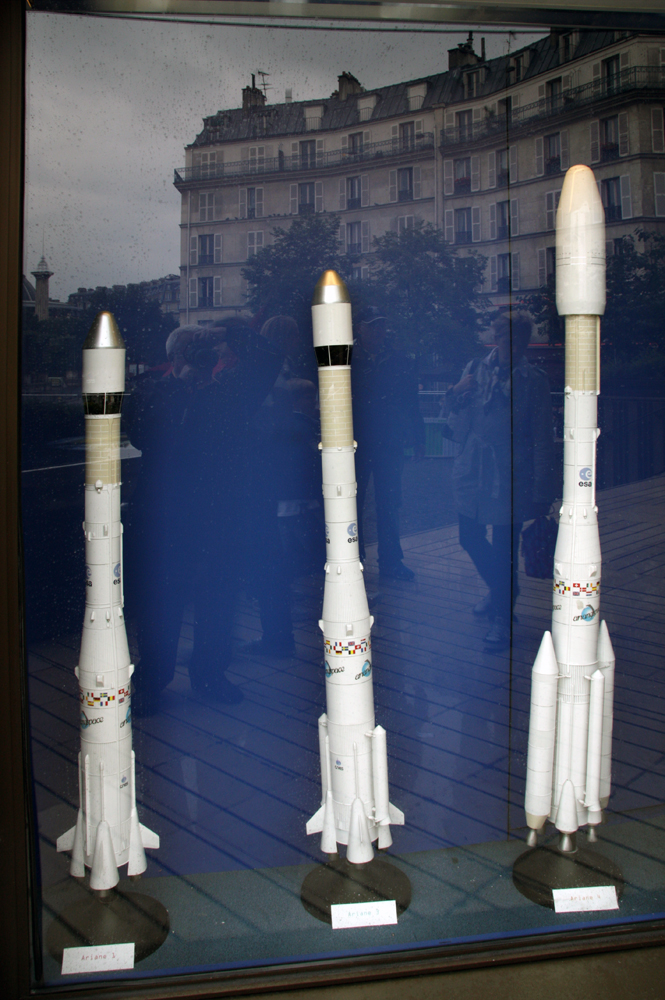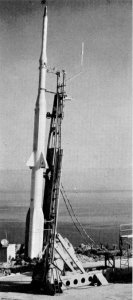|
Tacite (rocket)
The inaugural member of ONERA sounding rockets fleet, the Tacite (Tentative d'Analyse du Contraste Infrarouge Terre-Espace, for ''Attempt to Analyze the Earth-Space Infrared Contrast''), was a single-stage vehicle, used between 1965 and 1968. Description Designed and developed by the ''Office national d'études et de recherches aérospatiales'' (ONERA), it was a single-stage vehicle equipped with a SEPR 739-2 ''Stromboli'' engine fueled by ‘''Plastoline''’ propellant, offering a propulsion duration of 20 seconds. The rocket incorporates small nitrogen ejection nozzles to induce rotation and employs aerodynamic stabilization by a cruciform tailfin. With a total mass of 1738 kg (excluding the useful tip), Tacite reached a height of nearly 8 meters. It had the capability to propel a 285 kg payload to an altitude of 160 km. Launches Operational between 1965 and 1968, this rocket underwent four launches, experiencing one failure. See also * Tibère (rocket) * Bèrè ... [...More Info...] [...Related Items...] OR: [Wikipedia] [Google] [Baidu] |
CNES
CNES () is the French national space agency. Headquartered in central Paris, the agency is overseen by the ministries of the Armed Forces, Economy and Finance and Higher Education, Research and Innovation. It operates from the Toulouse Space Centre and the Guiana Space Centre. The president of CNES is Philippe Baptiste. CNES is a member of Institute of Space, its Applications and Technologies. It is Europe's largest national organization of its type. History CNES was established under President Charles de Gaulle in 1961. It is the world's third oldest space agency, after the Soviet space program (Russia), and NASA (United States). CNES was responsible for the training of French astronauts, until the last active CNES astronauts transferred to the European Space Agency in 2001. , CNES is working with Germany and a few other governments to start a modest research effort with the hope to propose a LOX/methane reusable launch vehicle by mid-2015. If built, flight testing w ... [...More Info...] [...Related Items...] OR: [Wikipedia] [Google] [Baidu] |
French Space Program
The French space program includes both commercial spaceflight, civil and military spaceflight activities. It is the third oldest national space program in the world, after the Soviet space program, Soviet (now Roscosmos, Russian) and Space policy of the United States, American space programs, and the largest space program in Europe. Background Space travel has long been a significant ambition in French culture. From the Gobelins Manufactory, Gobelins' 1664 tapestry representing a space rocket, to Jules Verne's 1865 novel ''From the Earth to the Moon'' and George Méliès' 1902 film ''A Trip to the Moon'', space and rocketry were present in French society long before the technological means appeared to allow the development of a space exploration program. During the late 18th century, Jean-François Pilâtre de Rozier, Jacques Charles and the Montgolfier brothers are seen as worldwide precursors and explorers of aeronautics, with the world record altitude then reached by a human a ... [...More Info...] [...Related Items...] OR: [Wikipedia] [Google] [Baidu] |
Mélanie (rocket)
Mélanie is a French solid rocket motor, 16 cm in diameter, initially used as first stage of the Monica rocket. There are two versions, Mélanie and ''"2Mélanie"'' (exact name unknown) : The first version was used on Monica I, II and IVA; while the improved ''"2Melanie"'', with twice the propellant, was used on Monica III, IVB and V. Melanie was later used in several ATEF and ONERA rockets. In the ONERA rockets, such as Daniel, Antarès and Berenice, Melanie was placed inside a 22 cm diameter cylindrical housing. This version delivered a total impulse of 48 kN.s with about 22 kilograms of propellant. See also * Bèrènice * Antarès (OPd-56-39-22D) * Veronique (rocket) * French space program The French space program includes both commercial spaceflight, civil and military spaceflight activities. It is the third oldest national space program in the world, after the Soviet space program, Soviet (now Roscosmos, Russian) and Space policy ... References ... [...More Info...] [...Related Items...] OR: [Wikipedia] [Google] [Baidu] |
Antarès (OPd-56-39-22D)
The Antarès (OPd-56-39-22D) was a French multistage rocket designed by ONERA for reentry studies. In the late 1950s, the study of missile warhead reentry necessitated the development of a more robust rocket than the existing OR, VD and OPd series. The Antarès rocket, designated OPd-56-39-22D during its developmental phase, was designed to facilitate the study of kinetic heating on objects flying at speeds up to Mach number, Mach 7. Description Measuring 12.2 meters in length and boasting a takeoff weight of up to 1785 kg, the rocket consisted of four stages. Three of these stages were ignited in an upward trajectory, reaching altitudes of up to 150 km, while the fourth stage accelerated the payload during its descent. Utilizing all four stages during ascent, Antares had the capability to send a payload of 35 kg to an altitude of 280 km. The first stage featured a SEPR 734-1 Vesuve motor with a diameter of 56 cm and a length of 3.5 m, delivering a tota ... [...More Info...] [...Related Items...] OR: [Wikipedia] [Google] [Baidu] |
Bérénice (rocket)
Bérénice was the designation of a four-stage French atmospheric reentry test rocket, developed by O.N.E.R.A. (''Office National d'Etudes et de Recherches Aérospatiales''). Description Bérénice was long, possessed a diameter of and weighed at launch. The takeoff thrust of Bérénice, which could carry a payload of to a height of , amounted to . The first stage, a SEPR-739 ''Stromboli'', was stabilised by four SEPR-P167 rockets developing . The second stage consisted of a SEPR-740 ''Stromboli'', almost identical to the first stage. The third stage was a SEPR-P200 ''Tramontane'' and the fourth stage comprised a '' Mélanie'' rocket and payload. Launches The twelve production rockets, Bérénice 001 to Bérénice 012, were launched by ONERA from Ile du Levant from 1962 to 1966. See also * Tibère (rocket) * Antarès (OPd-56-39-22D) * Mélanie (rocket) * Veronique (rocket) * French space program The French space program includes both commercial spaceflight, c ... [...More Info...] [...Related Items...] OR: [Wikipedia] [Google] [Baidu] |
Tibère (rocket)
Tibère was a French atmospheric reentry test rocket developed by ONERA, O.N.E.R.A. (''Office National d'Etudes et de Recherches Aérospatiales''). It evolved from its predecessor, Bérénice (rocket), Bèrènice, with development initiated in 1965 to support the ''ELECTRE'' reentry experiment program. Tibère, standing at a height of 14.5 m and weighing 4.5 tons, operated as a three-stage rocket. Description The first stage comprised a SEPR-739-2 ''Stromboli'', that, similar to Bèrènice and Titus, was encircled by four SEPR-P167 stabilization rockets. This was followed by another SEPR-739-2 ''Stromboli'' for the second stage, and the third stage housed a P.064 inherited from Diamant, Diamant A. The firing of the initial two stages during ascent propelled the upper composite (3rd stage + payload) to reach an altitude of 150 km. The ''Cassiopée'' attitude control system precisely oriented the composite before the P.064 motor accelerated it to high speed during descent ... [...More Info...] [...Related Items...] OR: [Wikipedia] [Google] [Baidu] |
CERES Ile Du Levant
CERES ("Centre d'Essais et de Recherches d'Engins Spéciaux" for "''Special Weapons Research and Tests Center"'') Ile du Levant was a French suborbital rocket launch site, located at Levant Island, Ile du Levant, and active between 1956 and 1968. CERES played a pivotal role in testing a wide array of tactical missiles used in France, as well as conducting tests for sounding rockets on behalf of CNES and European Space Research Organisation, ESRO. Additionally, the center was involved in experiments with ONERA and Société d'étude et de réalisation d'engins balistiques, SEREB experimental vehicles, solidifying its significance in the realm of missile research and testing. History In the early 1950s, a military missile test site was established at the French naval base on the Ile du Levant, an offshore island in the Mediterranean near Toulon. Known as CERES, it replaced a beach site at Pampelonne used for launches since 1948. This facility served as a Naval Air Force base thro ... [...More Info...] [...Related Items...] OR: [Wikipedia] [Google] [Baidu] |
DGA Essais De Missiles
DGA Essais de missiles (previously named CEL - Centre d'Essais des Landes) is a launch site for the test of military rockets and for launching sounding rockets in France. "DGA Essais de missiles" is situated between Biscarrosse and the Atlantic Ocean. "DGA Essais de missiles" went in service in 1967 as replacement for the former launch sites at CIEES, Hammaguir. A large number of rockets were tested from this site: Belier III, Dragon 1, Dragon 2B, Dragon 3, Rubis, Tacite, SSBS S112, Cora, Dauphin, SSBS S01, MSBS M012, MSBS M013, SSBS S02, Black Brant VC, MSBS M1, Tibère, Viper 3A, Forschungsflugkörper, MSBS M2, SSBS S2, MSBS M20, SSBS S3, Nike Orion, MSBS M4, Hades Hades (; , , later ), in the ancient Greek religion and Greek mythology, mythology, is the god of the dead and the king of the Greek underworld, underworld, with which his name became synonymous. Hades was the eldest son of Cronus and Rhea ..., Black Brant 9CM1, MSBS M45 and MSBS M51. Pads Th ... [...More Info...] [...Related Items...] OR: [Wikipedia] [Google] [Baidu] |
Nitrogen
Nitrogen is a chemical element; it has Symbol (chemistry), symbol N and atomic number 7. Nitrogen is a Nonmetal (chemistry), nonmetal and the lightest member of pnictogen, group 15 of the periodic table, often called the Pnictogen, pnictogens. It is a common element in the universe, estimated at Abundance of the chemical elements, seventh in total abundance in the Milky Way and the Solar System. At standard temperature and pressure, two atoms of the element chemical bond, bond to form N2, a colourless and odourless diatomic molecule, diatomic gas. N2 forms about 78% of Atmosphere of Earth, Earth's atmosphere, making it the most abundant chemical species in air. Because of the volatility of nitrogen compounds, nitrogen is relatively rare in the solid parts of the Earth. It was first discovered and isolated by Scottish physician Daniel Rutherford in 1772 and independently by Carl Wilhelm Scheele and Henry Cavendish at about the same time. The name was suggested by French chemist ... [...More Info...] [...Related Items...] OR: [Wikipedia] [Google] [Baidu] |





